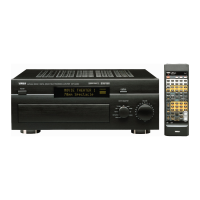58
SELECTING AND EDITING PROGRAM PARAMETERS
WHAT IS A SOUND FIELD?
In order to explain the impressive functions of the DSP system,
we need to first understand what a sound field really is.
What really creates the rich, full tones of a live instrument are the
multiple reflections from the walls of the room. In addition to making
the sound “live”, these reflections enable us to tell where the player is
situated, and the size and shape of the room in which we are sitting.
We can even tell whether it is highly reflective, with steel and glass
surfaces, or more absorbent—wood panels, carpeting and curtains.
THE ELEMENTS OF A SOUND FIELD
In any environment, in addition to the direct sound coming
straight to our ears from the player’s instrument, there are two distinct
types of sound reflections that combine to make up the sound field:
(1) Early Reflections. Reflected sounds reach our ears extremely
rapidly (50 ms — 100 ms after the direct sound), after reflecting from
one surface only—for example, from the ceiling or a wall. These
reflections fall into specific patterns as shown in the diagram on page
60 for any particular environment, and provide vital information to our
ears. Early reflections actually add clarity to the direct sound.
(2) Reverberations. These are caused by reflections from more than
one surface—walls, ceiling, the back of the room—so numerous that
they merge together to form a continuous sonic “afterglow”. They are
non-directional, and lessen the clarity of the direct sound.
Direct sound, early reflections and subsequent reverberation
taken together help us to determine the subjective size and shape of
the room, and it is this information that the DSP system reproduces
in order to create sound fields.
If you could create the appropriate early reflections and
subsequent reverberations in your listening room, you would be able
to create your own listening environment. The acoustics in your room
could be changed to those of a concert hall, a dance floor, or virtually
any size room at all. This ability to create sound fields at will is
exactly what Yamaha has done with the DSP system.
DSP programs consist of some parameters to determine
apparent room size, reverberation time, distance from you to the
performer, etc. In each program, those parameters are preset with
values precisely calculated by Yamaha to create the sound field
unique for the program. It is recommended to use DSP programs
without changing values of parameters, however, this unit also allows
you to create your own sound fields. Starting with one of the built-in
programs, you can adjust those parameters. Even if power is turned
off, your custom sound fields will remain in the DSP system’s
memory for about two weeks. The following pages detail how to
make your own sound fields.
CREATING YOUR OWN SOUND FIELDS

